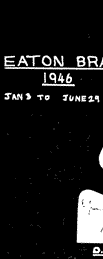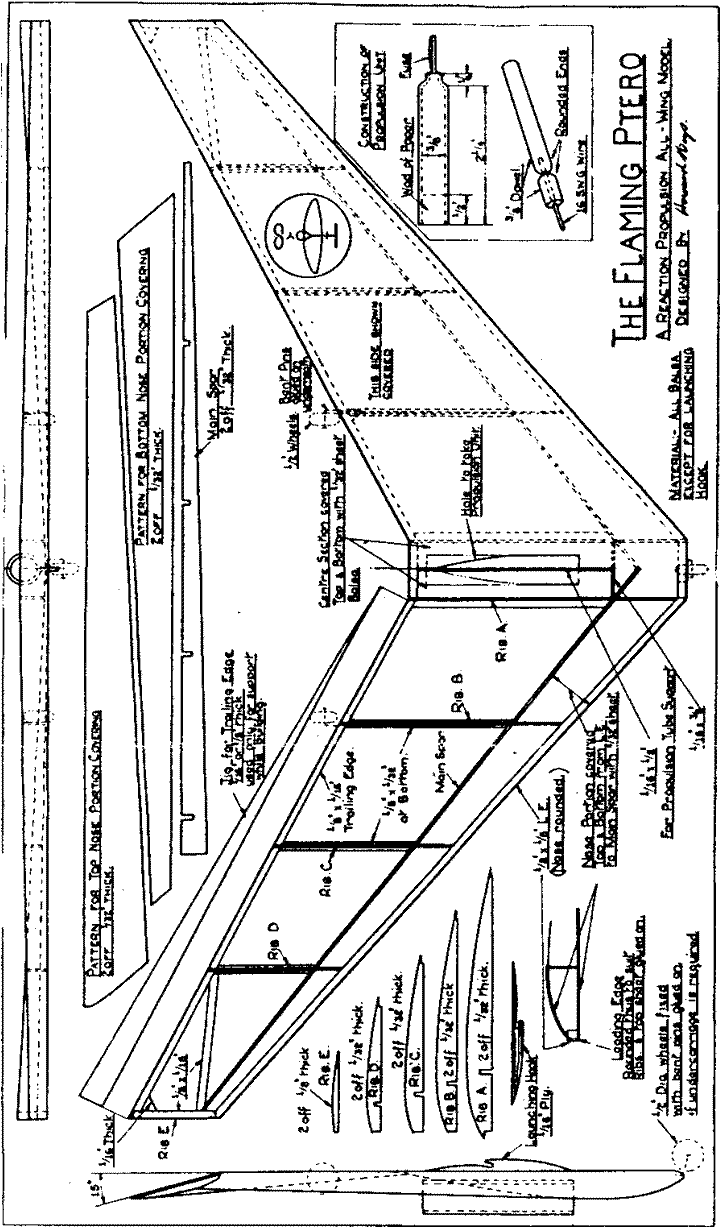|
|
|
|||
|
|
||||
|
|
||||
| Plan: Sparey's Rocket Plane | ||||
|
|
HOME | SITE MAP | FORUM | CONTACT |
|
||
|
ABOUT | MOTORS | MODELS | ARCHIVE | HISTORY | STORE | FAQ | LINKS
|
|
|
|
|
|
||||||||||||||||
|
Howard Boys’ Flaming Ptero
Reprinted from SAM 35 Speaks, August 1999 THE PROPULSION UNIT
The casing is made from cartridge paper about 3¼" wide and 8" long, wrapped round some |
|
||||||||||||||||
|
Before the gum is dry, give a turn of string round the tube about ½" from one end and adjust the dowel so that the join is under the string. Attach one end of the string to something solid and, holding the string taut rotate the tube until it has been pulled down on to the wire. Remove the dowel, leave to dry and cut to length. The propellant is made by mixing 15 parts saltpetre, 3 parts charcoal and 2 parts sulphur, the quantities being weighed. The charcoal can be made by heating dead willow wood in a tin with a loosely fitting lid in a fire until it stops smoking. Leave it to cool without taking off the lid, then break it up into a fine powder. Mix the charcoal, sulphur and saltpetre together and mash into a dryish paste with a little water. Put this paste into the casings, lightly press it down, gum a wad of paper on top and leave it to dry out. Fuses are made by dipping strips of blotting paper about 1½" wide in saltpetre solution. About a saltspoonful of saltpetre dissolved in a teaspoonful of hot water will be enough for about 6" of strip. It is then dried and pieces |

- SAM 35 Speaks, August 1999 (p. 43)
|
||||||||||||||||
|
In the August 1999 issue of SAM 35 Speaks (pp. 41-43), Doug McHard wrote about his youthful experiments with home-made rockets and rocket planes under the heading ‘SHEFFIELD'S SECRET WEAPONS FACTORY’ and told of his own experiences with the Flaming Ptero: |
|
||||||||||||||||
|
Two years [after Model Engineer published the plan for Sparey’s Rocket Plane] Howard Boys published the plan of his little rocket propelled flying wing “The Flaming Ptero”. The plan contained full instructions for formulating rocket fuel and making the rockets. These were clearly based upon the Sparey article, but were smaller and simplified, although the curious, but effective, method of forming the rocket nozzle was retained. The detailed ‘Propulsion Unit’ instructions clearly fell foul of the law, and shortly after the plan was made available, Boys was told that it was illegal. He therefore had an amusing little disclaimer printed on a leaflet and carefully tack-glued over the offending material. He demonstrated his well known political acumen by wording it in such a way as to suggest that the blame should be laid at the door of the police authorities! The little slip of paper was accurately positioned so that the “illegal” instructions could still be read as it was only stuck to the middle and the ends could be lifted to read beneath it. The complete illustration showing the construction of the rocket casing remained unobscured. Howard never had much time for bureaucracy. |
|||||||||||||||||

I have a picture of me launching one of Howard’s ‘Flaming Ptero’ models at Eaton Bray in 1948 with a very surprised looking gent observing the spectacle,and behind him in trench coat, Squadron Leader Peter Hunt of early radio control fame. I also built a 16" span D.H. Vampire during my time at the Bray with Dagra which used a Boys rocket [above right], but flew only once and the rocket provided so little thrust that it landed with the rocket still working, which duly ignited the tailplane – end of Vampire. |
|

- SAM 35 Speaks, August 1999 (p. 43)
|
|||||||||||||||
|
|
|
||||||||||||||||
Plan for Howard Boys’ Flaming Ptero
(A larger copy of the plan is also available to
view or download). |
|||||||||||||||||
|
|
|
||||||||||||||||
|
|
|
|
|
|
|
|
Acknowledgements - Article and plan contributed by Peter Tolhurst |
|
|
|
|
ABOUT | MOTORS | MODELS | ARCHIVE | HISTORY | STORE | FAQ | LINKS |
|
|
Terms of Use
|
Queries? Corrections? Additions?
Please
contact us.
|
|